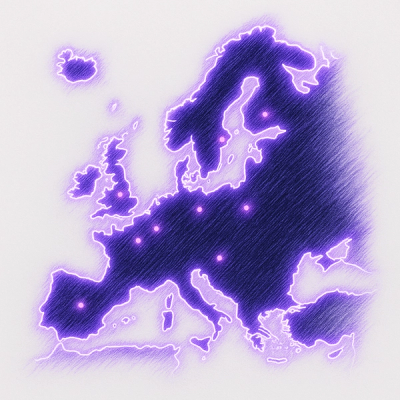Entropy Coders for Research and Production
The constriction library provides a set of composable entropy coding algorithms with a
focus on correctness, versatility, ease of use, compression performance, and
computational efficiency. The goals of constriction are three-fold:
- to facilitate research on novel lossless and lossy compression methods by
providing a composable set of primitives (e.g., you can can easily switch out a
Range Coder for an ANS coder without having to find a new library or change how you
represent exactly invertible entropy models);
- to simplify the transition from research code to deployed software by providing
similar APIs and binary compatible entropy coders for both Python (for rapid
prototyping on research code) and Rust (for turning successful prototypes into
standalone binaries, libraries, or WebAssembly modules); and
- to serve as a teaching resource by providing a variety of entropy coding
primitives within a single consistent framework. Check out our additional teaching
material from a university course
on data compression, which contains some problem sets where you use
constriction
(with solutions).
More Information: project website
Live demo: here's a web app
that started out as a machine-learning research project in Python and was later turned
into a web app by using constriction in a WebAssembly module).
Quick Start
Installing constriction for Python
pip install constriction~=0.4.1
Hello, World
You'll mostly use the stream submodule, which provides stream codes (like Range
Coding or ANS). The following example shows a simple encoding-decoding round trip. More
complex entropy models and other entropy coders are also supported, see section
"More Examples" below.
import constriction
import numpy as np
message = np.array([6, 10, -4, 2, 5, 2, 1, 0, 2], dtype=np.int32)
entropy_model = constriction.stream.model.QuantizedGaussian(-50, 50, 3.2, 9.6)
encoder = constriction.stream.stack.AnsCoder()
encoder.encode_reverse(message, entropy_model)
compressed = encoder.get_compressed()
print(f"compressed representation: {compressed}")
print(f"(in binary: {[bin(word) for word in compressed]})")
decoder = constriction.stream.stack.AnsCoder(compressed)
decoded = decoder.decode(entropy_model, 9)
assert np.all(decoded == message)
More Examples
Switching Out the Entropy Coding Algorithm
Let's take our "Hello, World" example from above and assume we want to
switch the entropy coding algorithm from ANS to Range Coding. But we don't want to
look for a new library or change how we represent entropy models and compressed data.
Luckily, we only have to modify a few lines of code:
import constriction
import numpy as np
message = np.array([6, 10, -4, 2, 5, 2, 1, 0, 2], dtype=np.int32)
entropy_model = constriction.stream.model.QuantizedGaussian(-50, 50, 3.2, 9.6)
encoder = constriction.stream.queue.RangeEncoder()
encoder.encode(message, entropy_model)
compressed = encoder.get_compressed()
print(f"compressed representation: {compressed}")
print(f"(in binary: {[bin(word) for word in compressed]})")
decoder = constriction.stream.queue.RangeDecoder(compressed)
decoded = decoder.decode(entropy_model, 9)
assert np.all(decoded == message)
Complex Entropy Models
This time, let's keep the entropy coding algorithm as it is but make the entropy model
more complex. We'll encode the first 5 symbols of the message again with a
QuantizedGaussian distribution, but this time we'll use individual model parameters
(means and standard deviations) for each of the 5 symbols. For the remaining 4 symbols,
we'll use a fixed categorical distribution, just to make it more interesting:
import constriction
import numpy as np
message = np.array([6, 10, -4, 2, 5, 2, 1, 0, 2], dtype=np.int32)
means = np.array([2.3, 6.1, -8.5, 4.1, 1.3], dtype=np.float32)
stds = np.array([6.2, 5.3, 3.8, 3.2, 4.7], dtype=np.float32)
entropy_model1 = constriction.stream.model.QuantizedGaussian(-50, 50)
entropy_model2 = constriction.stream.model.Categorical(
np.array([0.2, 0.5, 0.3], dtype=np.float32),
perfect=False
)
encoder = constriction.stream.queue.RangeEncoder()
encoder.encode(message[0:5], entropy_model1, means, stds)
encoder.encode(message[5:9], entropy_model2)
compressed = encoder.get_compressed()
print(f"compressed representation: {compressed}")
print(f"(in binary: {[bin(word) for word in compressed]})")
decoder = constriction.stream.queue.RangeDecoder(compressed)
decoded_part1 = decoder.decode(entropy_model1, means, stds)
decoded_part2 = decoder.decode(entropy_model2, 4)
assert np.all(np.concatenate((decoded_part1, decoded_part2)) == message)
You can define even more complex entropy models by providing an arbitrary Python
function for the cumulative distribution function (see
CustomModel and
ScipyModel). The
constriction library provides wrappers that turn your models into exactly
invertible fixed-point arithmetic since even tiny rounding errors could otherwise
completely break an entropy coding algorithm.
Exercise
We've shown examples of ANS coding with a simple entropy model, of
Range Coding with the same simple entropy model, and of Range coding with a complex
entropy model. One combination is still missing: ANS coding
with the complex entropy model from the last example above. This should be no problem
now, so try it out yourself:
- In the last example above, change both "queue.RangeEncoder" and "queue.RangeDecoder"
to "stack.AnsCoder" (ANS uses the same data structure for both encoding and decoding).
- Then change both occurrences of
.encode(...) to .encode_reverse(...) (since ANS
operates as a stack, i.e., last-in-first-out, we encode the symbols in reverse order
so that we can decode them in their normal order).
- Finally, there's one slightly subtle change: when encoding the message, switch the
order of the two lines that encode
message[0:5] and message[5:9], respectively.
Do not change the order of decoding though. This is again necessary because ANS
operates as a stack.
Congratulations, you've successfully implemented your first own compression scheme with
constriction.
Further Reading
You can find links to more examples and tutorials on the project
website. Or just dive right into the
documentation of range coding, ANS, and
entropy models.
If you're still new to the concept of entropy coding then check out the teaching
material.
Contributing
Pull requests and issue reports are welcome. Unless contributors explicitly state otherwise
at the time of contributing, all contributions will be assumed to be licensed under either
one of MIT license, Apache License Version 2.0, or Boost Software License Version 1.0, at
the choice of each licensee.
There's no official guide for contributions since nobody reads those anyway. Just be nice to
other people and act like a grown-up (i.e., it's OK to make mistakes as long as you strive
for improvement and are open to consider respectfully phrased opinions of other people).
License
This work is licensed under the terms of the MIT license, Apache License Version 2.0, or
Boost Software License Version 1.0. You can choose between one of them if you use this work.
See the files whose name start with LICENSE in this directory. The compiled python
extension module is linked with a number of third party libraries. Binary distributions of
the constriction python extension module contain a file LICENSE.html that includes all
licenses of all dependencies (the file is also available
online).
What's With the Name?
Constriction is a library of compression primitives with bindings for Rust and Python.
Pythons are a family of nonvenomous snakes that
subdue their prey by "compressing" it, a method known as
constriction.



